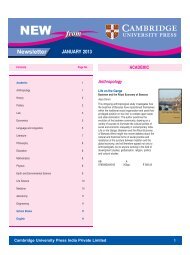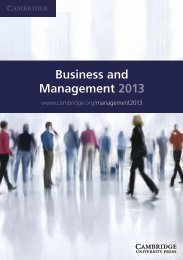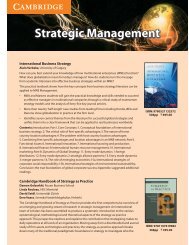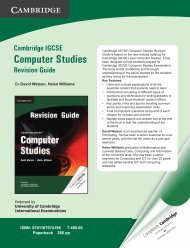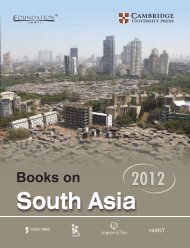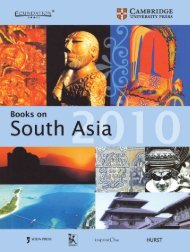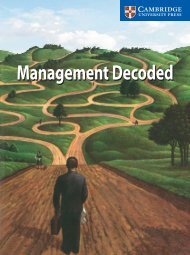India & Cambridge - Cambridge University Press India
India & Cambridge - Cambridge University Press India
India & Cambridge - Cambridge University Press India
- No tags were found...
You also want an ePaper? Increase the reach of your titles
YUMPU automatically turns print PDFs into web optimized ePapers that Google loves.
HISTORYIndigenous and WesternMedicine in Colonial <strong>India</strong>Madhuri SharmaThis book delves into the socialhistory of medicine and reflects onthe complexity of socialinteraction, between indigenousand western medicine in colonial<strong>India</strong>. The book draws upon a hostof authentic sources such as tracts,pamphlets, brochures, booklets ofvarious medicine shops and drugmanufacturing companiesfunctioning in the colonial era. This work analyses themedical market and entrepreneurship in medicine incolonial <strong>India</strong>. It deconstructs the then prevalent‘advertisements’, treating them both as a reflection on thecontemporaneous values and lifestyles and as a medium forthe creation of medical consumers.Emphasizing upon the question of class, gender and racialdiscriminations, the book also examines the interestgenerated by modern medical equipment such as thestethoscope and the thermometer, and the way in whichthese were used to reinforce the norms of social hierarchyand purdah system. This work also focuses on severaldebated issues such as birth control, sexuality, and theprinciples of brahmacharya. The book would be a usefulread for sociology and history graduates, as well asresearchers and medical professionals.Madhuri Sharma is a Fellow at Nehru Memorial Museumand Library, Teen Murti Bhavan, New Delhi.9788175968899 192pp HB ` 695.00Bombay Islam: TheReligious Economy of theWest <strong>India</strong>n Ocean,1840–1915Nile GreenAs a thriving port city, nineteenthcenturyBombay attractedmigrants from across <strong>India</strong> andbeyond. Nile Green’s Bombay Islamtraces the ties betweenindustrialization, imperialism andthe production of religion to showhow Muslim migration fueled demand for a wide range ofreligious suppliers, as Christian missionaries competed withMuslim religious entrepreneurs for a stake in the newmarket. Enabled by a colonial policy of non-intervention inreligious affairs, and powered by steam travel andvernacular printing, Bombay’s Islamic productions wereexported as far as South Africa and Iran. Connectinghistories of religion, labour and globalization, the bookexamines the role of ordinary people – mill hands andmerchants – in shaping the demand that drove the market.By drawing on hagiographies, travelogues, doctrinal works,and poems in Persian, Urdu and Arabic, Bombay Islamunravels a vernacular modernity that saw people fromacross the <strong>India</strong>n Ocean drawn into Bombay’s industrialeconomy of enchantment.Nile Green is Professor of South Asian and Islamic History atthe <strong>University</strong> of California, Los Angeles.19 B&W illustrations 2 maps9781107020764 344pp HB ` 995.00Race, Religion and Law inColonial <strong>India</strong>: Trials of anInterracial FamilyChandra MallampalliHow did British rule in <strong>India</strong> transformpersons from lower social classes?Could <strong>India</strong>ns from such classes risein the world by marrying Europeansand embracing their religion andcustoms? This book explores suchquestions by examining theintriguing story of an interracialfamily who lived in southern <strong>India</strong> inthe mid-nineteenth century. The family, which consisted oftwo untouchable brothers, both of whom married Eurasianwomen, became wealthy as distillers in the local community.A family dispute resulted in a landmark court case, Abrahamv. Abraham. Chandra Mallampalli uses this case to examinethe lives of those involved, and shows that far from beingproducts of a ‘civilizing mission’ who embraced the ways ofEnglishmen, the Abrahams were ultimately – when facedwith the strictures of the colonial legal system – obliged tocontend with hierarchy and racial difference.Chandra Mallampalli, Westmont College.6 B&W illustrations 3 maps9781107026988 280pp HB ` 995.00Shi’a Islam in Colonial <strong>India</strong>:Religion, Community andSectarianismJustin JonesInterest in Shi’a Islam has increasedgreatly in recent years, althoughShi’ism in the <strong>India</strong>n subcontinenthas remained largelyunderexplored. Focusing on theinfluential Shi’a minority ofLucknow and the United Provinces,a region that was largely under Shi’arule until 1856, this book traces thehistory of <strong>India</strong>n Shi’ism through the colonial period towardindependence in 1947. Drawing on a range of new sources,including religious writing, polemical literature and clericalbiography, it assesses seminal developments including thegrowth of Shi’a religious activism, madrasa education,missionary activity, ritual innovation and the politicizationof the Shi’a community. As a consequence of thesesignificant religious and social transformations, a Shi’asectarian identity developed that existed in separation fromrather than in interaction with its Sunni counterparts. In thisway the painful birth of modern sectarianism was initiated,the consequences of which are very much alive in SouthAsia today.Justin Jones, <strong>University</strong> of <strong>Cambridge</strong>.9781107026971 304pp HB ` 895.00order online at www.cambridgeindia.org11




